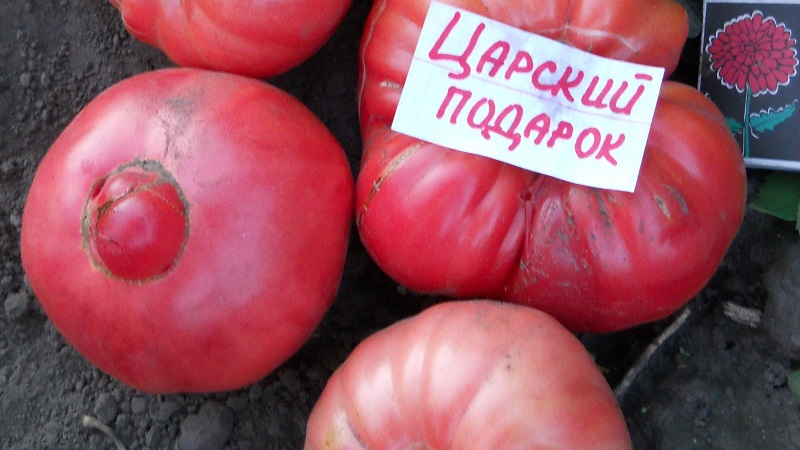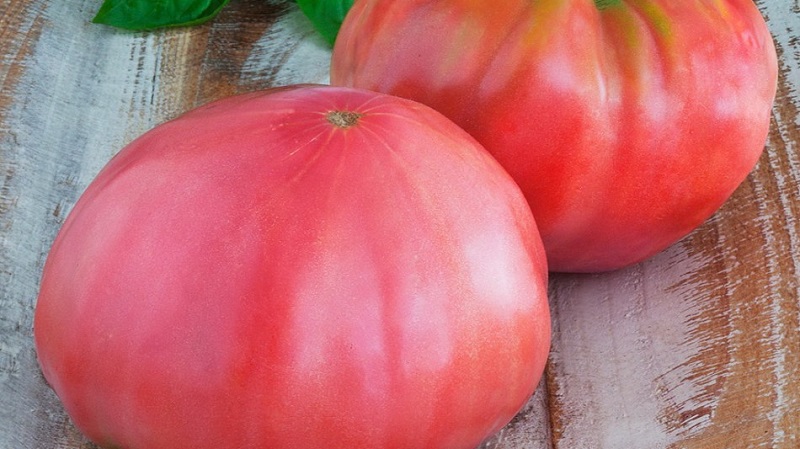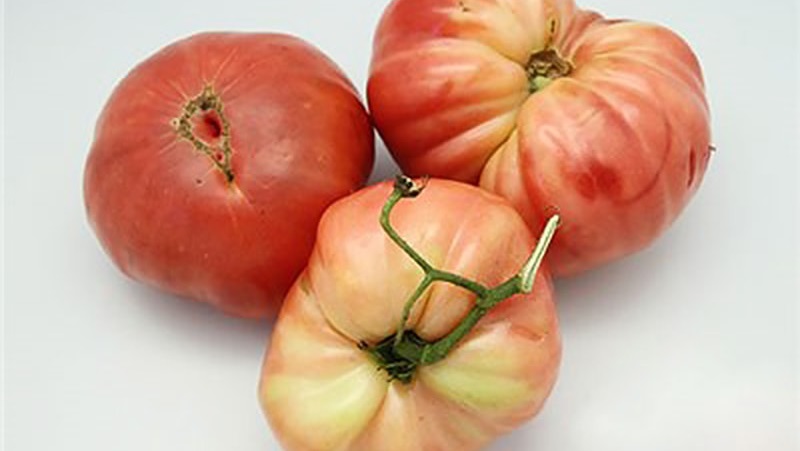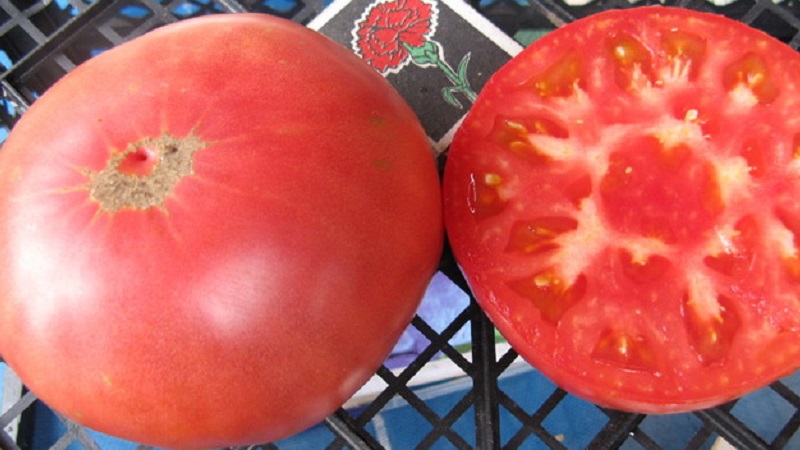We grow tomato "Tsar's Gift" in stages, starting with seedlings and ending with the collection of a bountiful harvest
Large red tomatoes are consistently popular with both gardeners and consumers. They are consumed fresh, preserved for the winter. They make tomato juice of a bright color. Most farmers give preference to just such fruits.
These are the fruits that the Tsar's gift variety gives. The culture is in demand in all regions of Russia and is included in the State Register of Breeding Achievements in 2007.
The content of the article
Characteristics and description of the variety
The Tsar's Gift is a variety bred by Russian breeders for growing in open ground and in greenhouses. Because of their round, flattened shape, tomatoes are called barrels. They have a bright, red-pink color.
Tomatoes have dense flesh, so they are stored in the cold for 20-25 days.
The high sugar content gives the fruit a sweetish flavor.
Features of the Tsar's gift
The main distinguishing feature of the Tsar's gift is its bright red color with a pearl tint. You can see in the photo how they look. These are giant tomatoes, with a round-barrel shape and pronounced ribbing on the sides.
Some specimens reach a mass of 500 g. Juicy, sugary pulp on a break. Matte, dense skin reliably protects against cracking.
The royal gift is a universal variety. The fruits are suitable for both fresh consumption and canning.
Plant determinant... The height of the bush reaches from 0.8 to 1 m. To prevent the branches of the plant from breaking, it is necessary to tie them to supports. To limit the growth of the bush in height, stepchildren are removed.
Important. The royal gift has a high yield, reaching up to 10 kg per 1 sq. m. These tomatoes are great for growing for sale.
Despite the volumetric size of the tomatoes, the bushes are quite compact.
Fruit characteristics, yield
| Parameters | Indicators |
| Bush type | The plant is determinate. Moderate branching. Leaves are dark green, simple in shape, large in size. The bush is small in height, reaching no more than 1 m.
When grown outdoors, it turns out to be more compact. The inflorescence is simple. The stalk has a joint. |
| Growing method | It is recommended to grow in open ground or under a film. |
| Yield | High yield of the variety, 10 kg per 1 sq. m |
| Fruit | Ripen with brushes, three to five pieces. The fruits are large, have an average weight of 250-300 g. Some fruits reach 500 g.
They have an interesting round-barrel shape, ribbing is expressed on the sides. When ripe, they acquire a bright red color with a pearl tint. The skin is firm enough to prevent cracking. The pulp of tomatoes is dense, juicy and sugary. There are few seeds, no less than six seed chambers. The taste is pleasant, rich-sweetish |
| Transportability | They tolerate transportation well. |
| Ripening terms | Mid-season variety. The first ripe fruits appear 105-110 days after germination. |
| Disease resistance | Resistance to major viral and fungal diseases. |
How to grow seedlings
Seeds sown two months before transplanting plants into open ground.
Seed preparation
The seeds are prepared and sowed. Taking care of the seeds will speed up germination and protect the plants from disease.
Planting seed preparation:
- All seeds are examined, those capable of germinating are selected, blackened and damaged ones are removed. An easier way: add a little salt to the water and soak the seeds for thirty minutes. The spoiled seeds float to the surface.
- To prevent diseases, they are treated with a disinfecting solution. Use an agent of your choice: hydrogen peroxide or potassium permanganate. The seeds are soaked in the selected product for two hours, and then thoroughly washed with water.
- For early germination, soak for 12 hours in a growth stimulator. Such drugs (for example, "Epin") are sold in all specialized stores for summer residents.

Capacity and soil
Sow the seeds into a container of sufficient size. Use store-bought trays and boxes or make pots themselves. When growing several bushes, seeds are sown immediately into a pot. When the plant has grown, it is dived and transplanted into a separate container, which should be at least 300 g.
Choose light soils. There is a large selection of soil in stores, but it's cheaper to prepare the soil mixture yourself. Take peat, turf and humus in equal proportions. With this composition, the soil will be nutritious and light.
We recommend disinfecting not only the seeds, but also the soil and containers. The earth is calcined in the oven and watered with a solution of potassium permanganate. The containers are sterilized with alcohol or high temperatures, and the container is also wiped with hydrogen peroxide and potassium permanganate.
Sowing
When the soil is prepared, proceed to sowing. Small grooves are made, the depth of which does not exceed 2 cm, and are spaced 3 cm apart. Seeds are poured at a distance of 2 cm from each other. Sprinkle with earth on top.
Abundant watering is not required. Cover with a film or a transparent lid, leave in a warm place. Plants do not need light before germination. If condensation appears on the top of the coating, it is removed by wiping with a cloth.
Growing and care
After the appearance of 2-3 leaves, the plant is transplanted into individual containers. Do not pinch the central root.
As it dries, the soil is watered. For this, settled water at room temperature is suitable. When watering, the water should not touch the greenery.
Three times during the cultivation of seedlings they make top dressing... A balanced complex of fertilizers is used. They are poured over the soil in which the tomatoes grow. 10 days after transplanting, the first feeding is applied. 3 days before transplanting into the ground, fertilize for the last time. The second feeding is done between them.
In order for the plant to better take root in a new place, the seedlings are hardened. Two weeks before disembarking at a permanent place, she is taken out into fresh air for 30 minutes, then the time spent outdoors is gradually increased. Simultaneously reduce the night temperature to +13 ° С
How to grow tomatoes
Seedlings are planted in a permanent place after warming up the soil. This is the second half of May.
Landing
Plants are watered abundantly and fed three days before planting, after transplanting they are watered once, then the soil is not moistened for two weeks.
Transplant beds seedlings cooked in the fall. The remains of plants are removed, and the soil is dug up. The soil is fertilized with ash and humus.
In the spring, the earth is dug up again. The soil should be disinfected by pouring a solution of potassium permanganate or copper sulfate.
Dig holes, the distance between them is kept 50-60 cm. The distance between the rows is 60–70 cm. The seats are staggered to save space. Immediately before planting, the seedlings are carefully removed from the pots along with a lump of earth. Placed in the holes, forming the roots towards the center. Wells with plants are poured with water at room temperature. When the water is absorbed, they are covered with soil.

Plant care
In caring for tomatoes, the Tsar's gift of difficulties does not arise.They are regularly watered, loosened and fertilized. Top dressing of soil foliar.
Important.Water with lukewarm, settled water, avoiding moisture on the leaves.
When the bushes have grown up and got stronger, we remove the side shoots so that the plant forms into one stem.
Features of cultivation and possible difficulties
A beginner gardener faces a number of difficulties:
- The bush grows tall. Garter required.
- When the soil is poor, few ovaries are formed. Increase the amount of feeding.
- A large amount of greenery on the plant indicates oversaturation of the soil, the fruits become smaller and slowly ripen.
- By reducing the number of flowers, you will increase the weight of the fruit.
- Cracking and wateriness of the fruit. This suggests that the grower removed too much foliage, and all the water went into the tomatoes.
Diseases and pests
Due to the high resistance of the tomato variety to typical tomato diseases, it is not afraid of fusarium, verticillosis, tobacco mosaic.
Nevertheless, preventive measures are needed:
- pre-planting soil treatment with a solution of potassium permanganate or copper sulfate;
- treatment of bushes with medicinal preparations for prevention late blight;
- spraying with "Fitosporin" or other non-toxic bio-preparations with antifungal effect;
- regular inspection of plantings for the presence of pests. A soap solution is used against aphids; industrial insecticides or a decoction of celandine are used in the fight against flying insects. Ash flour introduced into the soil under the bushes will help prevent the appearance of root parasites and slugs.

The nuances of growing in open ground and in a greenhouse
The Tsarsky Gift variety is suitable both for growing in a greenhouse and in the open field.
When cultivating a plant in a greenhouse, it is important not to forget to ventilate the room. To do this, periodically open windows in greenhouses.
In the open field, tomatoes require mulching. They use hay, burlap, straw and special film.
After transplanting into open ground, the bushes are covered with a film, and removed in warm weather.
Harvesting and application of the crop
A bright red saturated color is a sign of the maturity of tomatoes.
The variety is characterized by its versatility and is well suited for both fresh consumption and canning. Juices, lecho, winter preparations are prepared from the Tsar's gift.
Advantages and disadvantages of the variety
Benefits of the Tsar's Gift:
- bright fruit color;
- wonderful taste;
- high productivity;
- immunity to the main diseases of tomatoes;
- the possibility of growing indoors and outdoors;
- versatility of fruits, vegetables are perfect both for fresh use and for preservation;
The disadvantages include:
- necessity garters and pinching;
- exactingness to the composition of the soil;
- with high humidity, the fruits crack.

Another variety is a royal gift
The early ripe tomato variety Royal gift is similar to the Royal one in many ways. Suitable for both film shelters and open ground. The period from germination to harvest is 107-114 days. Plant indeterminate.
Fruits are large, red, ribbed sides. They have no voids. Average weight 200-300 g. Some fruits reach 500 g.
Suitable for salads and processing.
Due to its unpretentious care and high taste characteristics, the tomato variety Tsarsky Gift is in demand among domestic vegetable growers. Due to the high sugar content, the fruits have a pronounced rich taste. The tomato is characterized by undemanding care and easy adaptation to cold weather.
Reviews, photos and yield indicators indicate that the Tsarsky Gift and Royal Gift varieties are similar in all respects.
Farmers reviews
The royal gift will interest Russian farmers with its yield, beautiful, tasty and healthy fruits:
Alina, Kazan: “I planted it last year and was satisfied. The variety has a high yield - it has harvested about 10 kg per sq. m. In terms of ripening, the variety is average, but tasty, just sugar! The fruits turned out as in the picture. "
Elena Sozinova, Novosibirsk region: “I have been growing this variety for several years and already know many nuances with the help of which I achieve productivity and resistance to diseases. I live in Siberia, so I plant it in a greenhouse, carry out thorough care and do not use a growth activator. But the harvest is quite decent even without it. "
Sergey, Voronezh: “Every year I plant a Tsar's gift. This is a pretty tough tomato. He is not afraid of deteriorating weather, but the temperature should still be taken into account when transplanting seedlings into open ground. At first, it is better to cover young shoots with foil. The harvest is distinguished by large and juicy tomatoes. "

Conclusion
Tomato Tsarsky Gift is a variety with bright red fruits with pearl tint. Some tomatoes reach a weight of 500 g. Even a beginner gardener can cope with their cultivation, but in order not to be disappointed in the variety, observe the temperature regime, apply top dressing in a timely manner.